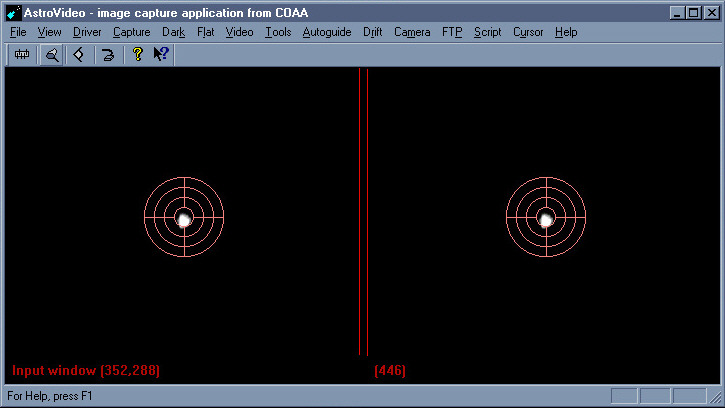What's
PEC?
(P)eriodic (E)rror (C)orrection
is a technique where keystrokes or guiding
inputs are used to teach the mount
electronics to compensate for mechanical
imperfections in the mount. There are many
sources of periodic error, but LX200 PEC
training targets the largest source, the worm
gear that drives the RA tracking. The LX200
worm takes 8 minutes to perform one full
revolution, so PEC training lasts for 8
minutes. Multiple 8 minute training sessions
can be made, with the LX200 averaging the
input values over the 8 minute period.
Manual
PEC Training
PEC training while looking
through a reticle eyepiece at the telescope
for eight minutes at a time isn't much fun.
Instead I used my SAC7 CCD, taking .1 second
exposures at high magnification and keeping
the star in the on-screen reticle that comes
with the AstroVideo software. This allowed me
to sit back in a deck chair inside the
observatory and comfortably train the worm.
Here's a screen shot showing how this looked
at the computer, with the training star
slightly below the center of the cross-hairs:

Manual
PEC Training: Results
KNOW THY EQUIPMENT. Gathering
and analyzing lots of data is a really good
way to learn about your equipment and it's
imperfections. It's also a great way to
measure the effectiveness of your efforts to
improve things - AND it gives you plenty to
do when the moon is bright ;)
I trained PEC manually and
measured the amount of error exhibited by my
system. To take the measurements, I took a
series of 120 10 second images of a star. I
then logged the position (in pixels) of the
centroid of the star. Finally I converted
pixels to ArcSeconds and plotted them as seen
in these charts. I developed a handy
spreadsheet which acts as a form for
gathering data, and which performs all the
calculations and generates the graphs. Feel
free to email me if you would like a copy.
Automated PEC
Training
PEC can also be trained using
guiding inputs from an autoguider. The 201XT
autoguider works well for this task. Pointing
at a magnitude 2-3 star, the 201XT will track
with .1 second exposures. By dropping the
LX200 into train mode after the 201XT has
started guiding, the guiding input from the
autoguider is used to perform precise PEC
training with multiple updates per second for
the entire 8 minute training period. As with
manual PEC training, multiple training
sessions should be performed to average the
results. I performed 4 automated PEC update
training sessions which lead to much improved
tracking.
A Note About Declination
The LX200 also has a facility
for training the DEC drive, but I haven't
tried it yet and have not used it in any of
the tests presented above. All DEC values
shown in this data come from an untrained DEC
drive. It occurred to me while analyzing this
data that the DEC numbers give an indication
of the accuracy of polar alignment. DEC was
not trained, and I was using stars along the
North-South meridian and near a declination
of zero degrees. This is a good position to
check for DEC drift associated with errors in
polar alignment. My values consistantly come
in very near ZERO DEC drift over 20 minutes,
indicating that my mount is aligned quite
accurately to the celestial pole.
However, the graphs also
demonstrate a trend - positive spikes in RA
have a corresponding positive spike in DEC,
likewise negative RA movements have
corresponding negative movements in DEC. This
means that changes in RA are causing changes
in DEC. The most likely culprit is ME! Having
the camera oriented in any way other than
perfectly orthogonal to the forks will cause
this phemonenon. To prove it, I've run the
final test again, this time after carefully
aligning the camera. Here
are the results.
Animations Highlight the
Difference PEC Makes!
I used the raw data to produce
animations which dramatically show the value
of PEC training.
This animation shows
how my LX200 follows a star over 20 minutes
with no PEC training.
Notice how the star oscillates back and
forth.
This animation was made
after training PEC with the autoguider. Although
there is still noticeable oscillation, the
distance from center that the star moves is
reduced significantly.
<< back
|